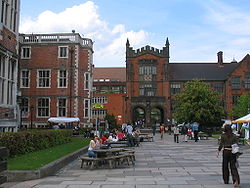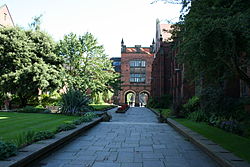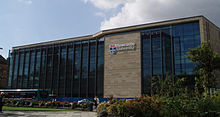- Newcastle University
-
Newcastle University 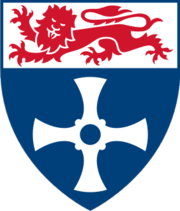
Shield from the arms of Newcastle UniversityEstablished 1834 – School of Medicine and Surgery
1963 – became independent from the University of DurhamType Public Endowment £32.3 million (2008–09)[1] Chancellor Sir Liam Donaldson Vice-Chancellor Prof. Chris Brink Admin. staff 5,000[2] Students 19,700[3] Undergraduates 14,060[3] Postgraduates 5,640[3] Location Newcastle upon Tyne, Tyne and Wear, UK
54°58′41″N 1°36′54″W / 54.978°N 1.615°WCoordinates: 54°58′41″N 1°36′54″W / 54.978°N 1.615°WCampus Urban Turnover £344 million (2007–08)[4]:16 Colours Blue (University)
old gold (Humanities)
royal blue (Science)
palatinate (Medicine)Affiliations Russell Group
EUA
N8 Group
ACU
Universities UKWebsite www.ncl.ac.uk 
Newcastle University is a major research-intensive university located in Newcastle upon Tyne in the north-east of England. It was established as a School of Medicine and Surgery in 1834 and became the University of Newcastle upon Tyne by an Act of Parliament in August 1963. Newcastle University is a member of the Russell Group,[5] an association of research-intensive UK universities. The University has one of the largest EU research portfolios in the UK.[6] The post-nominal letters of graduates commonly have N'cle attached to indicate the institution.[7]
Contents
History
The University has its origins in the School of Medicine and Surgery which was established in Newcastle upon Tyne in October 1834, providing basic lectures and practical demonstrations to around 26 students. In June 1851, following a dispute amongst the teaching staff, the School was split into two rival institutions: the majority forming the Newcastle College of Medicine, with the others establishing themselves as the Newcastle upon Tyne College of Medicine and Practical Science. By 1852, the majority college was formally linked to the University of Durham, its first 'Licence in Medicine' (Lic.Med) being awarded in 1856, and its teaching certificates were recognised by the University of London for graduation in medicine.[8] The two colleges amalgamated in 1857 and renamed the University of Durham College of Medicine in 1870.
Attempts to realise a place for the teaching of sciences in the city were finally met with the foundation of the College of Physical Science in 1871. The college offered instruction in mathematics, physics, chemistry and geology to meet the growing needs of the mining industry, becoming the Durham College of Physical Science in 1883 and then renamed after William George Armstrong as Armstrong College in 1904. Both these separate and independent institutions later became part of the University of Durham, whose 1908 Act formally recognised that the University consisted of two Divisions, Durham and Newcastle, on two different sites. By 1908, the Newcastle Division was teaching a full range of subjects in the Faculties of Medicine, Arts, and Science, which also included agriculture and engineering.[9]
Throughout the early 20th century, the medical and science colleges vastly outpaced the growth of their Durham counterparts and a Royal Commission in 1934 recommended the merger of the two colleges to form King's College, Durham. Growth of the Newcastle Division of the federal Durham University led to tensions within the structure and on 1 August 1963 an Act of Parliament separated the two, creating the University of Newcastle upon Tyne.[10]
Campus
The university occupies a campus site close to Haymarket in central Newcastle upon Tyne. It is located to the northwest of the city centre between the open spaces of Leazes Park and the Town Moor.
The Armstrong building is the oldest building on the campus and is the site of the original Armstrong College. The building was constructed in three stages; the north east wing was completed first at a cost of £18,000 and opened by HRH Princess Louise on 5 November 1888. The south-east wing, which includes the Jubilee Tower, and south-west wings were opened in 1894. The Jubilee Tower was built with surplus funds raised from an Exhibition to mark Queen Victoria's Jubilee in 1887. The north-west front, forming the main entrance, was completed in 1906 and features two stone figures to represent science and the arts. Much of the later construction work was financed by Sir Isaac Lowthian Bell, the metallurgist and former Lord Mayor of Newcastle, after whom the main tower is named. In 1906 it was opened by King Edward VII.[11]
The building contains the King's Hall, which serves as the university's chief hall for ceremonial purposes where Congregation ceremonies are held. It can contain 500 seats.[12] King Edward VII gave permission to call the Great Hall, King's Hall.[11] Graduation photographs are often taken in the University Quadrangle, next to the Armstrong building. In 1949 the Quadrangle was turned into a formal garden in memory of members of Newcastle University who gave their lives in the two World Wars.[13]
The Bruce Building is a former brewery, constructed between 1896 and 1900 on the site of the Hotspur Hotel, as the new premises of Newcastle Breweries Limited.[14][15]
The Devonshire Building, opened in 2004, incorporates in an energy efficient design photovoltaic cells which help to power the motorised shades which control the temperature of the building and geothermal heating coils. Its architects won awards in the Hadrian awards and the RICS Building of the Year Award 2004. The university won a Green Gown award for its construction.[16][17][18]
Plans for additions and improvements to the campus were made public in March 2008 and completed in 2010 at a cost of £200 million. They include a redevelopment of the south-east (Haymarket) façade with a five-storey King's Gate building and sculpture as well as new student accommodation. Two additional buildings for the school of medicine were also built.[19]
In addition to the city centre campus there are buildings such as the Dove Marine Laboratory located on Cullercoats Bay. The University also has two branches in Asia; in Malaysia and Singapore.
Newcastle University Library has received the Charter Mark five times in a row.[20] It consists of three main facilities. The Robinson Library is the main University library. It is named after Philip Robinson, a bookseller in the city following a bequest in the will of his widow Marjorie in 1989. A major refurbishment was completed in 2009. The Walton Library specialises in services for Biomedical Sciences in the Medical School. It is named after Lord Walton of Detchant, former Dean of the Faculty of Medicine and Professor of Neurology. The library has a relationship with the Northern region of the NHS allowing their staff to use the library for research and study. The Law Library specialises in resources relating to law. Some schools within the University, such as the School of Modern Languages, also have their own smaller libraries with smaller highly-specialised collections.[21]
Organisation
The current Chancellor is Sir Liam Donaldson. Donaldson was also the former Chief Medical Officer for England (1998 – May 2010). Donaldson assumed the position of Chancellor on 1 August 2009. The vice-chancellor is Chris Brink, a mathematician and lately vice-chancellor of the University of Stellenbosch.[22]
The University has a core population of 19,700 students (2006–2007), including more than 2,000 overseas students from over 100 countries.[3]
The university enjoys a friendly sporting rivalry with local universities: the Stan Calvert Cup[23] is contested by major sports teams from Newcastle and Northumbria University, and the Northumbrian Water University Boat Race takes place each year between the rowing clubs of Newcastle and Durham University.[24]
It holds a series of public lectures, named Insights, each year in the Curtis Auditorium in the Herschel Building. Many of the University's partnerships with companies, like Red Hat, are housed in the Herschel Annex.[25]
Newcastle was the only UK university to formally back the Jubilee Debt Campaign for the cancellation of debt in developing countries, and it has a strong ongoing commitment to the Make Poverty History campaign. At a high-profile honorary degree ceremony in January 2007, the University awarded honorary degrees to Bob Geldof, Gordon Brown MP, and Benjamin Mkapa (former president of Tanzania) among others, at an event which promoted debate on current debt-relief issues.[26]
In 2006, the University was granted Fair trade status, and from January 2007, it became a smoke-free campus. In September 2008, the university's first overseas branch was opened in Singapore, a Marine International campus called, NUMI Singapore.[27] In 2011, the university Medical School are to open a campus in Malaysia, called Newcastle University Medicine Malaysia (NUMed).[28]
The University has also been actively involved with several of the region's museums for many years; the Hancock Museum originally opened in 1884, and refurbished and re-opened in May 2009 – is one such example.[29]
Faculties and schools
Teaching schools within the University are based within three faculties. Each faculty is led by a Provost/Pro-vice chancellor and a team of Deans with specific responsibilities.
- Faculty of Humanities and Social Sciences
- School of Architecture, Planning and Landscape
- School of Arts and Cultures
- Newcastle University Business School
- Combined Studies Centre
- School of Education, Communication and Language Sciences
- School of English Literature, Language and Linguistics
- School of Geography, Politics and Sociology
- School of Historical Studies
- The Language Centre
- Newcastle Law School
- School of Modern Languages
- Faculty of Medical Sciences
- Newcastle Biomedicine
- School of Biomedical Sciences
- School of Dental Sciences
- School of Medical Sciences Education Development
- Postgraduate Institute for Medicine and Dentistry
- School of Psychology
- Faculty of Science, Agriculture and Engineering
- School of Agriculture, Food and Rural Development
- School of Biology
- School of Chemical Engineering and Advanced Materials
- School of Chemistry
- School of Civil Engineering and Geosciences
- School of Computing Science
- School of Electrical, Electronic and Computer Engineering
- School of Marine Science and Technology
- School of Mathematics and Statistics
- School of Mechanical and Systems Engineering
Business School
In 2002, Newcastle University Business School established the Business Accounting and Finance or 'Flying Start' degree in association with the ICAEW and PricewaterhouseCoopers. The course offers an accelerated route towards the ACA Chartered Accountancy qualification and is the Business School's Flagship programme.[30] Its success has since resulted in Lancaster University and Ernst & Young collaborating to establish a competing degree programme in 2005.[31]
The Business School was ranked 43rd in The Guardian League tables in 2011.
Medical School
The Medical School gained 143 out of a possible 144 points in its six subject areas in the Teaching Quality Assessment and was also the first institution in Europe, second in the world, to be given permission to pursue stem-cell research in human embryos. According to UCAS, Cambridge, Oxford and Newcastle are the most academically selective universities for entry to study medicine in the United Kingdom.[32] The BMC Medicine journal reported medical graduates from Oxford, Cambridge and Newcastle performed better in postgraduate tests than any other medical school in the UK.[33]
In 2008 the Medical School announced that they were expanding their campus to Malaysia.[34] In 2009 the University won a Queen's Anniversary Prize for their research into ageing.[35]
Law School
Newcastle Law School is the longest established law school in the north-east of England.[36] It boasts a number of recognised international and national experts in a variety of areas of legal scholarship ranging from Common and Chancery law, to International and European law, as well as contextual, socio-legal and theoretical legal studies.[37] It has been recognised for excellence in teaching and research by external bodies. In 2002–03, the Higher Education Funding Council for England (HEFCE) Teaching Quality Audit, 'warmly commended' the quality of the taught programmes and self-critical and reflective practice of the staff. The latest national Research Assessment Exercise (RAE) published in December 2008 showed 85% of Newcastle Law School's research reached international standards of quality. In the previous RAE in 2001, the School was awarded a grade 5 for its research.[37]
The Law School occupies four specially adapted late-Victorian town houses. The Staff Offices, the Alumni Lecture Theatre and seminar rooms as well as the Law Library are all located within the School buildings.[38] The current Head of School is Prof. Christopher Rodgers.[39]
The Law School is regarded as being one of the top institutions in the UK. It is ranked 3rd nationally by the Sunday Times University Guide 2011,[40] 11th by the The Times Good University Guide 2011[41] and 8th by The Guardian University Guide 2011.[42] In 2011, the University announced that it receives over 1000 applications for 170 places available each year.[43]
Newcastle has been ranked the number one UK law school in the prestigious Sunday Times University Guide 2012.[44]
Cavitation tunnel
Newcastle University has the second largest cavitation tunnel in the UK. Founded in 1950, and based in the Marine Science and Technology Department, the Emerson Cavitation Tunnel is used as a test basin for propellers, water turbines, underwater coatings and interaction of propellers with ice.[45]
Museums and galleries
The University is associated with a number of the region's museums and galleries, including the Great North Museum project, which is primarily based at the world-renowned Hancock Museum. The Great North Museum: Hancock also contains collections from two of the University's other museums, the Shefton Museum and the Museum of Antiquities.[46] The University's Hatton Gallery is also a part of the Great North Museum project, but remains within the Fine Art Building.
Coat of arms
As the successor of King's College, Durham, the University adopted as its coat of arms at its foundation in 1963 those which were originally granted to the Council of King's College in 1937. In the Letters Patent authorising the transfer the arms are blazoned Azure, a Cross of St Cuthbert Argent and in chief of the last a lion passant guardant Gules (On a blue shield, a silver square cross with flared ends, and on the top third of the shield which is silver, a red lion walking and looking towards the viewer). There is no motto.
Above the portals of the Union Society building are bas-relief carvings of the arms and mottoes of the University of Durham, Armstrong College and Durham University College of Medicine, the predecessor parts of Newcastle University.
Academic profile
Reputation and rankings
The university won the Sunday Times University of the Year award in 2000 and is ranked 9th best in the UK by the Webometrics Ranking of World Universities in 2007.[47] The majority of undergraduate subjects were also ranked in the top 10 or top 20 in the Times Good University Guide 2008 and all of its subjects are awarded at least 20 points out of 24 by the Quality Assurance Agency.[48] The University Library is the only one in the UK to have been awarded the government's Charter Mark for excellent customer services five times in a row.[49] The University has one of the best track records for graduate employment in the country, and the Careers Service has won seven prestigious national careers awards in recent years by the Institute of Career Guidance.[50]
In 2010 the University was short-listed to be The Times Higher Education University of the Year.[51][52]
In the 2011 QS World University Rankings, Newcastle was ranked 127th worldwide.[53]
The university's Cochrane Park sports facility has been named as a training venue for the teams playing football games at St. James' Park for the 2012 London Olympics.[54]
Rankings tables
UK University Rankings 2010 2009 2008 2007 2006 2005 2004 2003 2002 2001 2000 1999 1998 1997 1996 1995 1994 1993 The Times 21st[55] 20th[56] 23rd[48] 25th[57] 19th[58] 18th 17th= 16th 13th 17th 17th 19th 19th 22nd 17th 29th 28th= 23rd The Guardian 40th[59] 43rd[60] 40th[60] – 38th[61] 43rd[62] 56th[63] 30th[64] The Sunday Times 24th[65] 23rd[66] 25th 26th[67] 26th 21st[68] 22nd[68] 23rd[68] 18th[68] 20th[68] 22nd[68] 26th[68] The Daily Telegraph 23rd[69] FT 26th[70] 23rd[71] 23rd[72] 21st[73] The Independent / Complete 24th[74] 27th[75] 23rd[75] World Universities 2010 2009 2008 2007 2006 2005 2004 2003 QS World University Rankings[76] 140th[76] N/A N/A N/A N/A N/A N/A N/A THES - QS World University Rankings (From 2010 two separate rankings will be produced by the Times Higher Education World University Rankings and the QS World University Rankings) 158th[77] 162nd[78] 129th[79] 133rd[80] 168th[81] 179th[82] N/A Academic Ranking of World Universities 201–302nd[83] 201–302nd[84] 203–304th[85] 151–200th[86] 203–300th[87] 202–301st[88] 152–200th[89] Research
The university is ranked highly for its research. In the publication Research Fortnight it was named as fifth best in the UK for its research carried out across departments in 2007.[90]
Research centres and institutes
- Biopharmaceutical Bioprocessing Technology Centre (BBTC)
- Digital Institute (DI)
- Institute for Ageing and Health (IAH)
- Institute for Cell and Molecular Biosciences (ICAMB)
- Institute of Cellular Medicine (ICM)
- nanoLAB
- Institute for Policy and Practice (IPP)
- Institute for Research on Environment and Sustainability (IRES)
- Institute of Health and Society (IHS)
- Institute of Genetic Medicine (IGM)
- Institute of Neuroscience (IoN)
- Newcastle Institute for the Arts, Social Sciences and Humanities (NIASSH)
- Northern Institute for Cancer Research (NICR)
- North-east England Stem Cell Institute (NESCI)
- Sir Joseph Swan Institute for Energy Research (SWAN)
- Sir Jack Howcroft Institute for Vacancy of International Kingship Institute Northern Germany (VIKING)
Students' Union
The university has many student organisations. Newcastle University Students' Union is the students' union, which includes student-run sports clubs and societies.
Unlike the majority of other students' unions in the UK, Newcastle University Students' Union (NUSU) owns the building in which it is housed. The Union building was built in 1924 following a generous gift from an anonymous donor, who is now believed to have been Sir Cecil Cochrane, a major benefactor to the University.[91] It is built in the neo-Jacobean style and was designed by the local architect Robert Burns Dick whose firm designed the Laing Art Gallery, the towers of the Tyne Bridge and The Spanish City in Whitley Bay. It was opened on 22 October 1925 by the Rt. Hon. Lord Eustace Percy, who later served as Rector of King's College from 1937 to 1952. It is a Grade II listed building. From November 2010 to September 2011 the Union Building will undergo a redevelopment project for which the University has donated £8 million.
The Students' Union is run by six sabbatical officers and fifteen part time unpaid officer positions. The Students' Union also employs around 300 people in ancillary roles including bar staff and entertainment organisers. Artists that have performed at Students' Union include Maxïmo Park, Snow Patrol, Kosheen, The Fratellis, Coldplay, Low, Mercury Rev, Goldie Lookin' Chain, Chicane, The Hoosiers and Damien Rice.
The Courier is a weekly student newspaper. Established in 1948, the current weekly readership is around 12,000, most of which are students at the university. It is published every week during term time, usually on a Monday unless a major news event warrants a delay.[92] The Courier has won The Guardian's Student Newspaper of the Year award. In 2008, The Courier design editor Kerry Hyndman came runner up in the Guardian Student media award for Design for her work on the newspaper's entertainment pull-out, Pulp.[93] As part of a re-design of the paper in 2009/2010 Pulp, originally a separate publication was replaced by a lifestyle section in the main body of The Courier.
Newcastle Student Radio is a student radio station based in the university.[94] The station aims to cater for a wide range of musical tastes, anything from Metal and Punk to R&B and swing music.
Accommodation
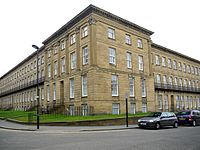 Leazes Terrace, a Grade I listed building, designed by Thomas Oliver and built by Richard Grainger, in 1829–34; now student accommodation.
Leazes Terrace, a Grade I listed building, designed by Thomas Oliver and built by Richard Grainger, in 1829–34; now student accommodation.
Newcastle University has many catered and non-catered halls of residence available to first-year students, located around the city of Newcastle.[95]
In 2008 a survey conducted by an independent website ranked Newcastle as the number one student city in the UK, with a score of 63% across the categories of going out, shops, transport, community and facilities.[96] In another 2008 survey, by MSN Travel, Newcastle was named as the number one university.[97]
Notable academic staff and alumni
Newcastle University has many notable academic staff and alumni, including politicians, business people, authors, actors, musicians, and sports people.[98]
See also
References
- ^ "Financial Statements 2008–09". Newcastle University. http://www.ncl.ac.uk/documents/financialstatement09.pdf. Retrieved 18 August 2010.
- ^ "Facts and Figures". Newcastle University. http://www.ncl.ac.uk/press.office/figures.htm. Retrieved 14 May 2011.
- ^ a b c d "Table 0a – All students by institution, mode of study, level of study, gender and domicile 2006/07" (Microsoft Excel spreadsheet). Higher Education Statistics Agency. http://www.hesa.ac.uk/dox/dataTables/studentsAndQualifiers/download/institution0607.xls. Retrieved 6 April 2008.
- ^ "Financial Statements 2007–08". Newcastle University. http://www.ncl.ac.uk/documents/financialstatement08.pdf. Retrieved 2 June 2009.
- ^ "The Russell Group". The Russell Group. http://www.russellgroup.ac.uk/. Retrieved 29 March 2008.
- ^ "Research at Newcastle". Newcastle University. 12 March 2008. http://www.ncl.ac.uk/research/. Retrieved 29 April 2008.
- ^ "House Style for University Publications". Newcastle University. 2003-06. http://www.ncl.ac.uk/web-development/units/house/general.php. Retrieved 19 November 2008.[dead link]
- ^ "Student lists". Senate House Library. http://www.shl.lon.ac.uk/specialcollections/archives/studentrecords.shtml. Retrieved 27 November 2010.
- ^ "Linguistics Association of Great Britain Conference 2006". Newcastle University. http://lagb2006.ncl.ac.uk/call.php. Retrieved 29 March 2008.
- ^ "Universities of Durham and Newcastle upon Tyne Act 1963" (PDF). Newcastle University. http://www.ncl.ac.uk/regulations/docs/statutes.pdf. Retrieved 7 October 2010.
- ^ a b "Royal opening for student services building". Newcastle University. 4 February 2010. http://www.ncl.ac.uk/press.office/press.release/item/royal-opening-for-newcastle-university-s-student-services-building. Retrieved 4 February 2010.
- ^ "King's Hall". Newcastle University. http://www.ncl.ac.uk/conferenceteam/meetings/oncampus/kingshall.htm. Retrieved 23 March 2009.
- ^ "Quadrangle". Newcastle University. 2009. http://www.ncl.ac.uk/about/visit/campusguide/quad.htm. Retrieved 27 August 2009.
- ^ "The Bruce Building". SINE Project. 8 July 2003. http://sine.ncl.ac.uk/features/bruce_building/bruce.asp. Retrieved 3 December 2008.
- ^ Bennison & Merrison (1990). A Centenary History of the Newcastle Breweries.
- ^ "Devonshire Building – The Hadrian Awards". Dewjoc Architects. http://www.hadrianawards.com/entry.php?entryid=155&x=3. Retrieved 2 November 2008.
- ^ "Accolade for Devonshire Building". Newcastle University. http://www.ncl.ac.uk/press.office/newslink/?ref=1111586484. Retrieved 2 November 2008.
- ^ "Devonshire Building praised by HEFCE". Newcastle University. http://www.ncl.ac.uk/press.office/newslink/index.html?ref=1105529728. Retrieved 2 November 2008.
- ^ "Newcastle University announces £200 million investment in its campus". Newcastle University. 26 March 2008. http://www.ncl.ac.uk/press.office/press.release/content.phtml?ref=1206461398. Retrieved 6 April 2008.
- ^ "Charter Mark". Newcastle University. http://www.ncl.ac.uk/library/about/chartermark.php. Retrieved 1 September 2008.
- ^ "Library". Newcastle University School of Computing Science. http://www.cs.ncl.ac.uk/teaching/information/library/. Retrieved 19 September 2010.
- ^ "Principal Officers". Newcastle University. Archived from the original on 10 December 2007. http://web.archive.org/web/20071210141845/http://www.ncl.ac.uk/about/today/academic/officers. Retrieved 7 June 2008.
- ^ "Stan Calvert". Union Society. http://unionsociety.co.uk/au/content/145655/stan_calvert/. Retrieved 23 September 2010.
- ^ "The University Boat Race". Newcastle University. http://www.ncl.ac.uk/cprs/news/item/the-university-boat-race. Retrieved 7 June 2008.
- ^ "Global computing giant joins forces with Newcastle". Newcastle University. 3 March 2010. http://www.ncl.ac.uk/press.office/press.release/item/global-computing-giant-joins-forces-with-newcastle-university. Retrieved 14 March 2010.
- ^ "Debt campaigners honoured by Newcastle University". Jubilee Debt Campaign. 8 January 2007. http://www.jubileedebtcampaign.org.uk/Debt20campaigners20honoured20by20Newcastle20University+2832.twl. Retrieved 7 June 2008.
- ^ "International – Singapore". Newcastle University. 19 September 2008. http://www.ncl.ac.uk/international/country/asia/singapore/. Retrieved 28 September 2010.
- ^ "NUMed". Newcastle University Medicine Malaysia. http://www.ncl.ac.uk/numed/. Retrieved 10 October 2010.
- ^ "Museums". Newcastle University. http://www.ncl.ac.uk/undergraduate/newcastle/museums.htm. Retrieved 10 October 2010.
- ^ "Flying Start Degree Programme". Newcastle University. http://www.ncl.ac.uk/nubs/undergrad/flyingstart/. Retrieved 15 August 2008.
- ^ "The Ernst & Young Degree". Lancaster University. http://www.lums.lancs.ac.uk/departments/Accounting/undergraduate/eydegree/. Retrieved 15 August 2008.
- ^ "UCAS". UCAS. 15 September 2008. http://www.ucas.com/. Retrieved 29 March 2008.
- ^ "Call for medical training reform". BBC News. 18 February 2008. http://news.bbc.co.uk/1/hi/health/7242897.stm. Retrieved 1 April 2008.
- ^ "NUMed Malaysia". Newcastle University Medicine Malaysia. 2009. http://numed.ncl.ac.uk/. Retrieved 29 May 2009.
- ^ "Ageing research wins Queen's Anniversary Prize". Newcastle University. 18 November 2009. http://www.ncl.ac.uk/press.office/press.release/item/ageing-research-wins-queen-s-anniversary-prize. Retrieved 7 April 2010.
- ^ "The Newcastle Law School". Newcastle University. 2 January 2008. http://www.ncl.ac.uk/nuls/about/index.htm. Retrieved 29 March 2008.
- ^ a b "The Newcastle Law School". Newcastle University. 2 January 2008. http://www.ncl.ac.uk/nuls/about/index.htm. Retrieved 20 June 2011.
- ^ "The Newcastle Law School". Newcastle University. 2 January 2008. http://www.ncl.ac.uk/nuls/undergraduate/why/facilities.htm. Retrieved 20 June 2011.
- ^ "The Newcastle Law School". Newcastle University. 20 June 2011. http://www.ncl.ac.uk/nuls/about/index.htm. Retrieved 20 June 2011.
- ^ "Newcastle named third-best UK law school". Newcastle University. 20 October 2010. http://www.ncl.ac.uk/alumni/arches/page.htm?law-school-top. Retrieved 1 November 2010.
- ^ Naughton, Philippe (20 June 2008). "University League Tables (Law)". The Times (London). http://extras.timesonline.co.uk/tol_gug/gooduniversityguide.php?AC_sub=Law&x=19&y=10&sub=38. Retrieved 20 June 2008.
- ^ "University League Tables (Law)". The Guardian (London). 8 June 2010. http://www.guardian.co.uk/education/table/2010/jun/04/university-guide-law. Retrieved 28 July 2010.
- ^ "The Newcastle Law School". Newcastle University. 2 January 2008. http://www.ncl.ac.uk/nuls/undergraduate/apply/. Retrieved 18 June 2011.
- ^ "The Newcastle Law School". Newcastle University. 2 January 2008. http://www.ncl.ac.uk/nuls/about/news/item/newcastle-law-school-ranked-number-one-law-school-in-the-uk. Retrieved 15November 2011.
- ^ "Emerson Cavitation Tunnel History" (PDF). Newcastle University School of Marine Science and Technology. http://tpod.ncl.ac.uk/TPod/ECT%20History.pdf. Retrieved 29 August 2008.
- ^ "Our History (Great North Museum)". Tyne and Wear Museums. 2009. http://www.twmuseums.org.uk/greatnorthmuseum/ourhistory/. Retrieved 30 May 2009.
- ^ "Top Universities in the UK". Webometrics Ranking of The World. http://www.webometrics.info/rank_by_country.asp?country=uk. Retrieved 4 April 2008.
- ^ a b Naughton, Philippe. "Good University Guide". The Times (London). http://extras.timesonline.co.uk/gug/gooduniversityguide.php. Retrieved 29 March 2008.
- ^ "Library Gains Prestigious 5th Charter Mark Award". Newcastle University. http://www.ncl.ac.uk/library/about/chartermark.php. Retrieved 29 March 2008.
- ^ "National award for Careers Service". Newcastle University. 15 September 2004. http://www.ncl.ac.uk/press.office/newslink/index.html?ref=1095248805. Retrieved 29 March 2008.
- ^ "The Times Higher Education Shortlist". 27 September 2010. http://www.timeshighereducation.co.uk/hybrid.asp?typeCode=554. Retrieved 16 October 2010.
- ^ "University shortlisted for top award". 27 September 2010. http://www.ncl.ac.uk/press.office/press.release/item/university-shortlisted-for-top-award. Retrieved 16 October 2010.
- ^ "Newcastle University". Top Universities. http://www.topuniversities.com/institution/newcastle-university/wur. Retrieved 2 October 2011.
- ^ "Newcastle University named Olympic 2012 training venue". BBC News. 23 March 2011. http://news.bbc.co.uk/sport1/hi/olympics/london_2012/9433856.stm. Retrieved 23 March 2011.
- ^ Naughton, Philippe (1 June 2009). "University League Tables". The Times (London). http://extras.timesonline.co.uk/tol_gug/gooduniversityguide.php. Retrieved 5 December 2009.
- ^ Naughton, Philippe (20 June 2008). "University League Tables". The Times (London). http://extras.timesonline.co.uk/tol_gug/gooduniversityguide.php. Retrieved 20 June 2008.
- ^ Naughton, Philippe. "The Times Good University Guide 2007 – Top Universities 2007 League Table". The Times (London). http://www.timesonline.co.uk/displayPopup/0,,102571,00.html. Retrieved 3 November 2007.
- ^ "The Times Top Universities". The Times (London). http://www.timesonline.co.uk/displayPopup/0,,32607,00.html. Retrieved 3 November 2007.
- ^ "University guide 2010: University league table". The Guardian (London). 12 May 2009. http://www.guardian.co.uk/education/table/2009/may/12/university-league-table. Retrieved 12 May 2009.
- ^ a b "University ranking by institution". The Guardian (London). http://browse.guardian.co.uk/education?SearchBySubject=&FirstRow=29&SortOrderDirection=&SortOrderColumn=GuardianTeachingScore&Subject=University+ranking&Institution=. Retrieved 29 October 2007.
- ^ "University ranking by institution". The Guardian (London). http://browse.guardian.co.uk/education/2006?SearchBySubject=&FirstRow=20&SortOrderDirection=&SortOrderColumn=GuardianTeachingScore&Subject=Institution-wide&Institution=. Retrieved 29 October 2007.
- ^ "University ranking by institution". The Guardian (London). http://education.guardian.co.uk/universityguide2005/table/0,,-5163901,00.html?start=40&index=3&index=3. Retrieved 29 October 2007.
- ^ "University ranking by institution 2004". The Guardian (London). http://education.guardian.co.uk/universityguide2004/table/0,,1222167,00.html. Retrieved 19 January 2009.
- ^ "University ranking by institution". The Guardian 2003 (University Guide 2004) (London). http://education.guardian.co.uk/higher/unitable/0,,-4668575,00.html. Retrieved 7 April 2010.
- ^ "The Sunday Times University League Table". The Sunday Times (London). http://extras.timesonline.co.uk/stug/universityguide.php. Retrieved 13 September 2009.
- ^ "The Sunday Times University League Table". The Sunday Times (London). http://extras.timesonline.co.uk/stug/universityguide.php. Retrieved 8 October 2008.
- ^ "The Sunday Times University League Table" (PDF). The Sunday Times (London). http://extras.timesonline.co.uk/stug2006/stug2006.pdf. Retrieved 3 November 2007.
- ^ a b c d e f g "University ranking based on performance over 10 years" (PDF). The Times (London). 2007. http://extras.timesonline.co.uk/pdfs/univ07ten.pdf. Retrieved 28 April 2008.
- ^ "University league table". The Daily Telegraph (London). 30 July 2007. http://www.telegraph.co.uk/news/main.jhtml;jsessionid=HXFCSGXMNVABTQFIQMFCFGGAVCBQYIV0?xml=/news/2007/07/30/ncambs430.xml. Retrieved 29 October 2007.
- ^ "The FT 2003 University ranking". Financial Times 2003. http://www.grb.uk.com/448.0.html?cHash=5015838e9d&tx_ttnews%5Btt_news%5D=9&tx_ttnews%5Buid%5D=9.
- ^ "FT league table 2001". FT league tables 2001. http://specials.ft.com/universities2001/FT3HLLAN6LC.html.
- ^ "FT league table 1999–2000". FT league tables 1999–2000. http://specials.ft.com/ln/ftsurveys/industry/pdf/top100table.pdf.
- ^ "FT league table 2000". FT league tables 2000. http://specials.ft.com/ln/ftsurveys/industry/scbbbe.htm.
- ^ "The Independent University League Table". The Independent. UK. http://www.thecompleteuniversityguide.co.uk/single.htm?ipg=8726.
- ^ a b "The Complete University Guide". The Independent (London). 24 April 2008. http://www.independent.co.uk/news/education/higher/the-main-league-table-2009-813839.html. Retrieved 7 April 2010.
- ^ a b "QS World University Rankings 2010 Results". http://www.topuniversities.com/university-rankings/world-university-rankings/2010/results.
- ^ "THES – QS World University Rankings 2009". THES. http://www.topuniversities.com/university-rankings/world-university-rankings/2009/results/101-200/. Retrieved 5 December 2009.
- ^ "THES – QS World University Rankings 2007". THES. http://www.topuniversities.com/university_rankings/results/2008/overall_rankings/fullrankings/. Retrieved 13 January 2009.[dead link]
- ^ "THES – QS World University Rankings 2007". THES. http://www.topuniversities.com/worlduniversityrankings/results/2006/overall_top_200_full_details/. Retrieved 13 January 2009.[dead link]
- ^ "THES – QS World University Rankings 2006". THES. http://www.topuniversities.com/worlduniversityrankings/results/2006/overall_top_200_full_details/. Retrieved 13 January 2009.[dead link]
- ^ "THES – QS World University Rankings 2005". THES. http://www.topuniversities.com/worlduniversityrankings/results/2005/top_200_universities/. Retrieved 13 January 2009.[dead link]
- ^ "THES – QS World University Rankings 2004". THES. http://www.timeshighereducation.co.uk/hybrid.asp?typeCode=153. Retrieved 13 January 2009.
- ^ "Academic Ranking of World Universities 2009". Shanghai Jiao Tong University. http://www.arwu.org/ARWU2009.jsp. Retrieved 5 December 2009.
- ^ "Academic Ranking of World Universities 2008". Shanghai Jiao Tong University. Archived from the original on 22 August 2008. http://web.archive.org/web/20080822033350/http://www.arwu.org/rank2008/ARWU2008_TopEuro(EN).htm. Retrieved 13 January 2009.
- ^ "Academic Ranking of World Universities 2007". Shanghai Jiao Tong University. http://ed.sjtu.edu.cn/rank/2007/ARWU2007FullListByRank.pdf. Retrieved 3 November 2007.
- ^ "Academic Ranking of World Universities 2006". Shanghai Jiao Tong University. http://ed.sjtu.edu.cn/rank/2006/ARWU2006FULLLIST-BY%20RANK%20(PDF).pdf. Retrieved 13 January 2009.
- ^ "Academic Ranking of World Universities 2005". Shanghai Jiao Tong University. http://ed.sjtu.edu.cn/rank/2005/ARWU2005FullList2.pdf. Retrieved 13 January 2009.
- ^ "Academic Ranking of World Universities 2004". Shanghai Jiao Tong University. http://ed.sjtu.edu.cn/rank/2004/top500(202-301).htm. Retrieved 13 January 2009.
- ^ "Academic Ranking of World Universities 2003". Shanghai Jiao Tong University. http://ed.sjtu.edu.cn/rank/2003/Top102-500.pdf. Retrieved 13 January 2009.
- ^ "Research Success Rankings 2006–07" (PDF). Research Fortnight. 12 September 2007. http://www.researchresearch.com/media/pdf/Rankings0607.pdf. Retrieved 29 March 2008.[dead link]
- ^ Bettenson, E (1971). The University of Newcastle upon Tyne: a historical introduction, 1834–1971. University of Newcastle upon Tyne. ISBN 0900565322.
- ^ "Contact us". The Courier. http://www.thecourieronline.co.uk/content/206425/. Retrieved 12 March 2010.
- ^ "On course to win". The Guardian (London). 29 September 2008. http://www.guardian.co.uk/media/2008/sep/29/guardian.student.media.awards. Retrieved 8 December 2008.
- ^ NSR – Newcastle Student Radio
- ^ "List of Accommodation Sites". Newcastle University. 13 March 2007. Archived from the original on 17 April 2007. http://web.archive.org/web/20070417111347/http://www.ncl.ac.uk/accommodation/about/List_of_Accommodation/index.php. Retrieved 17 May 2007.
- ^ "Newcastle named best university town in Britain". Newcastle University. 19 June 2008. http://www.ncl.ac.uk/press.office/press.release/content.phtml?ref=1213866424. Retrieved 15 July 2008.
- ^ "1. Newcastle". MSN Travel. 2008. Archived from the original on 22 August 2008. http://web.archive.org/web/20080822113129/http://travel.uk.msn.com/inspiration/gallery.aspx?cp-documentid=9206286&imageindex=10. Retrieved 12 January 2009.
- ^ "The Alumni Association". Newcastle University. 2009. http://www.ncl.ac.uk/alumni/. Retrieved 29 May 2009.
External links
Newcastle University Main Article Newcastle University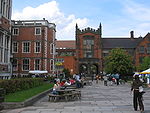
People Faculties Sport and Student Life Museums Great North Museum (Hancock Museum · Hatton Gallery · Museum of Antiquities · Shefton Museum) · Centre for LifeFacilities and Research Miscellaneous Chancellors of the University of Newcastle upon Tyne Universities and colleges in North East England Universities Further Education colleges Bishop Auckland · CCAD · Darlington · Derwentside · New Durham · East Durham · Gateshead · Hartlepool · Middlesbrough · Newcastle · Northumberland · Redcar & Cleveland · South Tyneside · Stockton Riverside · Sunderland · Tyne MetropolitanSixth form colleges Russell Group of UK research universities Birmingham · Bristol · Cambridge · Cardiff · Edinburgh · Glasgow · Imperial College London · King's College London · Leeds · Liverpool · London School of Economics · Manchester · Newcastle · Nottingham · Oxford · Queen's · Sheffield · Southampton · University College London · WarwickCategories:- Newcastle upon Tyne
- Newcastle University
- Russell Group
- Association of Commonwealth Universities
- Educational institutions established in 1834
- Exempt charities
- 1834 establishments in England
- Faculty of Humanities and Social Sciences
Wikimedia Foundation. 2010.

